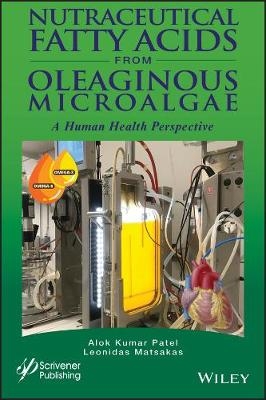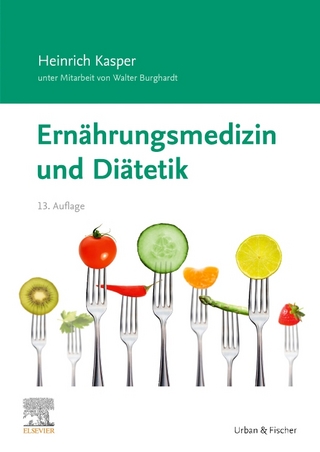
Nutraceutical Fatty Acids from Oleaginous Microalgae
Wiley-Scrivener (Verlag)
978-1-119-63171-2 (ISBN)
Some saturated and monounsaturated fatty acids can be synthesized by humans, whereas long-chain polyunsaturated fatty acids (PUFAs) such as α-linolenic acid and linoleic acid cannot and are deemed essential. The products of these acids, such as DHA, which is important for early visual and neurological development, are extremely important to human health. Replacing SFAs with omega-3 and omega-6 fatty acids in the diet reduce the risk of cardiovascular diseases and prevent Alzheimer's, bipolar disorder, and schizophrenia, among other benefits.
The ever-rising global demand for omega-3 & 6 PUFAs, however, cannot be met solely by fish oil, due to diminishing fish stocks and pollution of marine ecosystems, which has led to increased interest in alternative sustainable sources. Vegetable oils from genetically engineered plant oilseeds and microorganisms are two potential alternatives to fish oil, even though omega-3 PUFAs are highest in the latter. Although transgenic plants present numerous advantages, their production is dependent on seasonal and climatic conditions and the availability of arable land. Moreover, there are public concerns regarding the cultivation of transgenic crops in open ecosystems. These, together with regulatory issues restrict the large-scale production of genetically modified crops. Microorganisms, however, are known natural producers of microbial oils similar to those obtained from plants and animals and a possible source of nutritionally important omega-3 & 6 PUFAs.
This groundbreaking volume presents invaluable new research on essential fatty acids, their production from various oleaginous microorganisms, biochemical and metabolic engineering to improve PUFAs content in oil, extraction and purification of omega 3 fatty acids, and the current market scenario. Whether a veteran engineer or scientist using it as a reference or a professor using it as a textbook, this outstanding new volume is a must-have for any engineer or scientist working in food science.
Alok Kumar Patel, PhD, is working as a senior researcher in Biochemical Process Engineering, Luleå University of Technology, Lulea, Sweden to produce nutraceuticals from oleaginous microalgae. He finished his master's degree in biotechnology in 2011 and joined as a research assistant in Food Borne Infection Surveillance Unit, (Global Disease Detection India Center) CDC, USA in collaboration with National Center for Disease Control, Ministry of Health & Family Welfare, Government of India. He got his PhD in Biotechnology from IIT Roorkee in 2017. His research interest is mainly focused on the development of biotechnological processes for conversion of organic matter to bioenergy, biofuels and biochemicals, process optimization, pretreatment of biomass, nutraceuticals and value-added products from microorganisms, and biorefineries. Leonidas Matsakas, PhD, is working as an assistant professor in the Biochemical Process Engineering group at Luleå University of Technology. He received his PhD in Biotechnology from the school of Chemical Engineering at National Technical University of Athens in 2015. After that, he joined the Biochemical Process Engineering group of LTU as postdoc fellow and later became senior lecturer at the same group. His research interest is focused on developing biomass biorefinery processes, inclusing establishing novel pretreatment and fractionation technologies for the fractionation of lignocellulosic biomass to cellulose, hemicellulose and lignin and the conversion of these streams to biofuels, biobased chemicals and biomaterials via biochemical and thermochemical routes.
1 Introduction to Essential Fatty Acids 1
Alok Patel, Ulrika Rova, Paul Christakopoulos and Leonidas Matsakas
1.1 Introduction 2
1.2 Biosynthesis of PUFAs 4
1.3 Sources of Essential Fatty Acids and Daily Intake Requirement 5
1.4 Biological Role of Essential Fatty Acids 7
1.4.1 Effect on Cell Membrane Structure 7
1.4.2 Impact on Vision 9
1.4.3 Brain Function 9
1.4.4 Biosynthesis of Lipid Mediators 10
1.4.5 Effect of Omega Fatty Acids on the Regulation of Gene Expression 10
1.5 Effect of Essential Fatty Acid on Human Health (Disease Prevention and Treatment) 10
1.5.1 Neonatal Development 10
1.5.2 Gestation and Pregnancy 11
1.5.3 Cardiovascular Disease 11
1.5.4 Cancer Inhibition 12
1.5.5 Rheumatoid Arthritis 12
1.5.6 Effect on Suicide Risk in Mood Disorders 12
1.6 Concluding Remarks 12
References 13
2 Nutraceutical Fatty Acid Production in Marine Microalgae and Cyanobacteria 23
Anders K. Nilsson, Carlos Jiménez and Angela Wulff
2.1 Introduction 24
2.2 Fatty Acid Synthesis 26
2.3 Glycerolipid Synthesis and Lipid Accumulation 30
2.4 Current LC-PUFA Sources and the Potential Benefits of Using Marine Microalgae 32
2.5 Nutraceutical Fatty Acids in Marine Microalgae and Species of Interest 35
2.5.1 α-Linolenic Acid (18:3 n-3, Δ9,12,15) 37
2.5.2 Stearidonic Acid (18:4 n-3, Δ6,9,12,15) 38
2.5.3 Eicosanoid Acid (EPA, 20:5 n-3, Δ5,8,11,14,17) and Docosahexaenoic Acid (DHA, 22:6 n-3, Δ4,7,10,13,16,19) 38
2.5.4 Docosapentaenoic Acid (22:5 n-3, Δ7,10,13,16,19) 39
2.5.5 γ-Linolenic Acid (18:3 n-6, Δ6,9,12) 40
2.5.6 Arachidonic Acid (20:4 n-6, Δ5,8,11,14) 41
2.6 Autotrophic and Heterotrophic Cultivation 42
2.7 Cultivation from Laboratory to Industrial Scale 43
2.8 Optimizing Growth Condition to Promote Lipid Accumulation and Desired FA Profiles 48
2.8.1 Temperature Effect 49
2.8.2 Irradiance 50
2.8.3 Growth Rate 52
2.8.4 Nitrogen and Phosphorous 52
2.8.5 Co2 53
2.8.6 Salinity 54
2.9 Genetic Engineering to Promote Lipid Accumulation and Tailoring of Fatty Acid Profiles 54
2.10 Conclusions 56
2.11 Acknowledgements 57
References 57
3 Production of PUFAs as Dietary and Health Supplements from Oleaginous Microalgae Utilizing Inexpensive Renewable Substrates 77
Dimitra Karageorgou, Georgios Bakratsas and Petros Katapodis
3.1 Introduction 78
3.2 PUFAs as Dietary and Health Supplements 79
3.3 Microalgae as Source of PUFAs 82
3.4 Systems for Microalgal Cultivation 89
3.5 Use of Alternative Substrates for Microalgal Growth 90
3.6 Factors that Affect the Heterotrophic and/or Mixotrophic Cultures 97
3.7 Conclusions 101
3.8 Future Perspectives 101
3.9 Acknowledgements 102
References 102
4 Lipid and Poly-Unsaturated Fatty Acid Production by Oleaginous Microorganisms Cultivated on Hydrophobic Substrates 115
Markella Tzirita, Bríd Quilty and Seraphim Papanikolaou
4.1 Lipid Production (Single Cell Oil) 116
4.2 Lipid Biodegradation and Synthesis 118
4.3 Hydrophobic Substrates 122
4.3.1 Waste Fats, Oils and Grease (FOG) 122
4.3.2 Olive-Mill Wastewater (OMW) 123
4.4 Oleaginous Microorganisms 124
4.5 Conclusions 127
References 136
5 Overview of Microbial Production of Omega-3-Polyunsaturated Fatty Acid 145
Farha Deeba, Kukkala Kiran Kumar and Naseem A. Gaur
5.1 Introduction 145
5.2 Microbial Sources of ω-3 PUFA 146
5.3 ω-3 PUFA Biosynthesis in Microbial Cells 149
5.3.1 Aerobic Desaturase and Elongase Pathway 151
5.3.2 Anaerobic Polyketide Synthase (PKS) Pathway 153
5.4 Factors Affecting ω-3 PUFA Production 154
5.4.1 Temperature 154
5.4.2 pH 155
5.4.3 Aeration 155
5.4.4 Media Composition 155
5.4.5 Incubation Time 156
5.5 Stabilization of ω-3 PUFA 156
5.6 Conclusions 157
References 157
6 Autotrophic Cultivation of Microalgae for the Production of Polyunsaturated Fatty Acid 165
Pallavi Saxena, Mukesh Kumar and Harish
6.1 Introduction 165
6.2 Importance of PUFAs 170
6.3 Biosynthesis of PUFA in Autotrophic Algae 171
6.4 Harvesting of Algae and Extraction of Fatty Acids 173
6.5 Metabolic Engineering Towards Increasing Production of PUFA’s by Algae 175
6.6 Conclusion 178
6.7 Acknowledgement 178
References 178
7 Production of Omega-3 and Omega-6 PUFA from Food Crops and Fishes 187
Km Sartaj and R. Prasad
7.1 Introduction 188
7.2 PUFA as a Dietary Supplement 189
7.2.1 Omega-3 (n-3) Fatty Acids 189
7.2.2 Omega-6 (n-6) Fatty Acids 190
7.2.3 Health Aspects and Physiological Functions of PUFA 190
7.3 Biosynthesis and Metabolism of PUFA 191
7.4 Potential Commodities for PUFA Production 193
7.4.1 Food Crops 193
7.4.1.1 Soybean Seeds 197
7.4.1.2 Rapeseed 197
7.4.1.3 Safflower 198
7.4.1.4 Sesame and Linseed 198
7.4.1.5 Sunflower 198
7.4.2 Transgenic Plants 198
7.4.3 Fishes 198
7.4.3.1 Fish Bioecology and Lipid Content 199
7.5 Alternate Sources of PUFA 200
7.6 Future Avenues 200
7.7 Conclusion 203
References 203
8 The Role of Metabolic Engineering for Enhancing PUFA Production in Microalgae 209
Neha Arora
8.1 Introduction 209
8.2 LC-PUFA Biosynthesis in Microalgae 212
8.2.1 Conventional Aerobic Pathway 212
8.2.2 Anaerobic Pathway 214
8.3 Identification and Characterization of Enzymes Involved in PUFA Synthesis 214
8.4 Metabolic Engineering for Enhancing the LC-PUFA
Production in Microalgae 215
8.5 Conclusion and Future Perspective 222
References 223
9 Health Perspective of Nutraceutical Fatty Acids; (Omega-3 and Omega-6 Fatty Acids) 227
Sneha Sawant Desai and Varsha Kelkar Mane
9.1 Introduction 228
9.1.1 Biochemistry of Fatty Acids 228
9.1.2 Overview of Fatty Acid Synthesis 231
9.1.3 Strategies for PUFA Accumulation in Microalgae 232
9.2 Health Benefits of PUFA 234
9.2.1 Omega-6 Fatty Acids 234
9.2.1.1 Linoleic Acid (LA) 234
9.2.1.2 γ-Linolenic Acid (GLA) 234
9.2.1.3 Arachidonic Acid (ARA) 235
9.2.2 Omega-3 Fatty Acids 236
9.2.2.1 Alpha-Linolenic Acid (ALA) 236
9.2.2.2 Stearidonic Acid (SDA) 237
9.2.2.3 Docosahexanoic Acid (DHA) 237
9.2.2.4 Eicosapentaenoic Acid (EPA) 239
9.3 Conclusion 240
References 241
10 Extraction and Purification of PUFA from Microbial Biomass 249
Amit Kumar Sharma, Venkateswarlu Chintala, Praveen Ghodke, Parteek Prasher and Alok Patel
10.1 Introduction 250
10.2 Biochemical Composition of Microalgae 251
10.2.1 Carbohydrates 251
10.2.2 Proteins 252
10.2.3 Lipids 252
10.3 Microalgae as a Source of Polyunsaturated Fatty Acids 253
10.4 Composition of PUFAs in Microbial Biomass 254
10.5 Methods of Lipid Extraction from Microbial Biomass 255
10.5.1 Microalgae Cell Disruption Methods 256
10.5.1.1 Mechanical Cell Disruption Methods 257
10.5.1.2 Non-Mechanical Cell Disruption Methods 260
10.5.2 Lipid Extraction Methods 260
10.5.2.1 Mechanical Extraction Method 261
10.5.2.2 Solvent Extraction Methods 261
10.5.2.3 Green Solvents Extraction Methods 264
10.5.2.4 Supercritical Extraction Method 265
10.6 Purification and Enrichment of PUFAs 266
10.6.1 Low-Temperature Crystallization Enrichment 270
10.6.2 Urea Complexation 270
10.6.3 Distillation Method 271
10.6.4 Enzymatic Purification 271
10.6.5 Chromatographic Separation 272
10.6.6 Supercritical Fluid Fractionation (SFF) 273
10.7 Concluding Remarks 273
References 274
11 Market Perspective of EPA and DHA Production from Microalgae 281
Jyoti Sharma, Pampi Sarmah and Narsi R Bishnoi
11.1 Introduction 281
11.2 Categories of Omega-3 Fatty Acids and Their Health Benefits 283
11.3 Brain Development 284
11.4 Cardiovascular Diseases 285
11.5 Present Sources of Omega-3 PUFAs 286
11.6 Why Microalgae? 287
11.7 Factors Affecting Growth and Fatty Acid Composition of Microalgae 289
11.8 Algal Oil Extraction, Purification and Its Refining Techniques 291
11.9 Microalgae as a Boon for Long-Chain Omega-3 PUFAs 292
References 294
12 Oleaginous Microalgae – A Potential Tool for Biorefinery-Based Industry 299
Riti Thapar Kapoor
12.1 Introduction 299
12.2 Industrial Applications of Microalgae 302
12.3 Use of Microalgae as Biofertilizer 302
12.4 Microalgae as a Food Component 303
12.5 Microalgae as a Nutraceutical 303
12.6 Pigments and Carotenoids 304
12.7 Phycobilins 305
12.8 Fatty Acids 305
12.9 Animal Nutrition 306
12.10 Safety Related Issues Related to Microalgal Nutraceuticals 307
12.11 Application in Pharmaceutical Industry 307
12.12 Utilization of Microalgae in Cosmetics Production 308
12.13 Microalgal Application in Wastewater Treatment 308
12.14 Factors Affecting Lipid Production in Microalgae 309
12.14.1 Light Intensity 309
12.14.2 Temperature 309
12.14.3 Nutrient Availability 310
12.14.4 Salinity Stress 310
12.14.5 Metal Stress 313
12.15 Application of Microalgae in Biofuel Production 313
12.15.1 Advantages of Using Microalgae for Biofuel Production 313
12.16 Biodiesel 315
12.17 Biogas 315
12.18 Hydrogen 315
12.19 Biosyngas 316
12.20 Ethanol 316
12.21 Cultivation of Microalgae for Biofuel Production 316
12.21.1 Open Microalgal System 316
12.21.2 Closed Microalgal System 317
12.21.3 Hybrid Microalgal System 317
12.22 Current Research Status in India 317
12.23 Concluding Remarks and Future Prospectives 318
12.24 Acknowledgements 318
References 318
Index 331
| Erscheinungsdatum | 03.09.2020 |
|---|---|
| Sprache | englisch |
| Maße | 10 x 10 mm |
| Gewicht | 28 g |
| Themenwelt | Medizin / Pharmazie ► Gesundheitsfachberufe ► Diätassistenz / Ernährungsberatung |
| Technik ► Lebensmitteltechnologie | |
| Weitere Fachgebiete ► Land- / Forstwirtschaft / Fischerei | |
| ISBN-10 | 1-119-63171-8 / 1119631718 |
| ISBN-13 | 978-1-119-63171-2 / 9781119631712 |
| Zustand | Neuware |
| Informationen gemäß Produktsicherheitsverordnung (GPSR) | |
| Haben Sie eine Frage zum Produkt? |
aus dem Bereich


